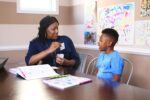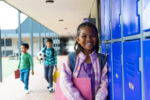When the governor of Nevada announced that school buildings would remain shuttered for the rest of the school year on April 21 due to the COVID-19 virus, I reached out to fellow teachers, students, and students’ families to discuss the news. While the fact that we would not be returning to the building was certain, nearly every other detail about the rest of the school year was uncertain. How would grading policies change? When could students collect their personal items? What would happen with summer training programs for team sports?
Now that many of those questions have been answered, students, their families, and school staff have settled into a new normal. Several schools nationwide have even adopted innovative ways to send off their graduating classes by hosting drive-thru graduations and virtual celebrations.
However, the one question still at the forefront in the minds of many parents and students is what the 2020–2021 school year will look like. While there are no concrete answers to this question, recent updates from the Centers for Disease Control and Prevention (CDC) offer some valuable guidance.
Will Students Return to the Classroom?
As with many questions surrounding schooling in the time of a pandemic, the answer to this question is, “It depends.” Education Week has begun collecting information on states’ plans to reopen school buildings, and those plans vary widely. There are several factors that government officials, health experts, and school administrators are taking into consideration.
- Environment – The CDC has recommended drastic changes to learning environments. Students’ desks should be six feet apart, which means that, depending on the school, class sizes would need to be decreased significantly. Surfaces should regularly be disinfected, and spaces that house the most students (like gyms and cafeterias) should alter the policies dictating how many students can occupy those spaces at one time.
- Behavior – The importance of handwashing cannot be underestimated. While hand sanitizer can be used, washing hands with soap and water is the preferred method. Students should stay home whenever possible and should wear face coverings when appropriate. Schools should also post signs to remind students and staff of these behavioral best practices and should make resources and reminders readily available.
- Operations – This refers to how schools are run day-to-day. The CDC recommends that schools protect the most vulnerable populations by providing alternative options for these students. Schools should also have effective communication systems and staff training programs in place.
A Spectrum of Risk
Ideally, to curb the spread of the coronavirus, schools would adopt the lowest-risk approach, which is to have all classes and activities conducted online rather than in person. Because this is not feasible for some school districts, the CDC has provided guiding principles that are divided into three categories: lowest risk, more risk, and highest risk. The highest risk category looks most similar to the pre-pandemic classroom, with students sharing supplies and interacting with each other and school staff members face-to-face in full-capacity classrooms.
Promising Developments
While policies can be put in place to mitigate the risk of spreading COVID-19, many parents and educators are still concerned about students returning to school without a vaccine. According to one poll, only 46 percent of parents support having their children return to school in-person before there is a vaccine.
However, there have been promising developments in this regard. Dr. Anthony Fauci, one of the country’s leading infectious disease experts and a member of the White House coronavirus task force, predicts that there will be “a couple of hundred million doses” of a vaccine by 2021. This timeline does little to quell fears about students’ health during the upcoming school year, but the results offer some hope in the face of a potential second wave of COVID-19 infections in the fall.
Health Concerns Remain
One of the reasons the pandemic has been so challenging to manage is that experts’ understanding of it has changed and evolved by the day. At first, it was believed young people were largely immune from contracting COVID-19, the disease caused by the coronavirus. However, recent discoveries have revealed a possible connection between COVID-19 and inflammatory illness. According to Harvard Health, this complication of the COVID-19 virus, called “multisystem inflammatory syndrome in children (MIS-C),” can cause problems with a child’s heart or other organs, which may be life-threatening. The condition is similar to Kawasaki disease, which is also an inflammatory illness that can cause heart problems. Cases of MIS-C have been very rare, but it is still recommended that parents and healthcare professionals remain vigilant to identify symptoms associated with the syndrome.
What if an Infected Person Enters the School Building?
If a school discovers an infected person has been in the building and in contact with others, the CDC recommends that students and most staff are dismissed for two to five days to prevent the spread of the virus. The nature of dismissals will differ depending on a wide range of factors, so be sure to consult local health officials’ recommendations for your school district. During the dismissal period, the CDC recommends a thorough cleaning of the building. During the transition to digital learning, they suggest that teachers try to ensure continuity of education and that administrators clearly communicate with students and families.
Recommendations
While there are different predictions about what the return to in-person schooling might look like, there are some uniform guidelines about what everyone should do to keep themselves and others safe. The CDC recommends that everyone do the following:
- Wash your hands often.
- Avoid close contact.
- Cover your mouth and nose with a cloth covering when around others.
- Cover coughs and sneezes.
- Clean and disinfect surfaces.
- Monitor your health.
Online Schools
Even before the COVID crisis, many parents have been choosing to enroll their children in online schools for various reasons. At most K12-powered schools, classes do not occur in a traditional school building but instead at home or wherever there’s an internet connection. Since kids attending virtual schools don’t gather physically in a building, exposure to the COVID virus at school is not a concern, and online classes have not been impacted. Explore A Day in the Life of K12-powered students for a behind-the-scenes look at how it works.
If you’re concerned about sending your child back to a brick-and-mortar school in the fall and want more information about attending a fully virtual school, visit K12 to learn more about online schools and find a virtual school near you. K12 also provides several resources for parents whose students are now learning from home, including access to free ebooks on Big Universe.
Additional Resources
Below are other resources to help you and your family stay as safe as possible during this unprecedented moment:
















































































































